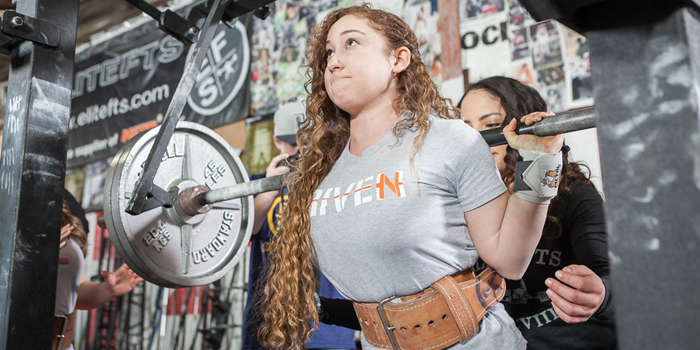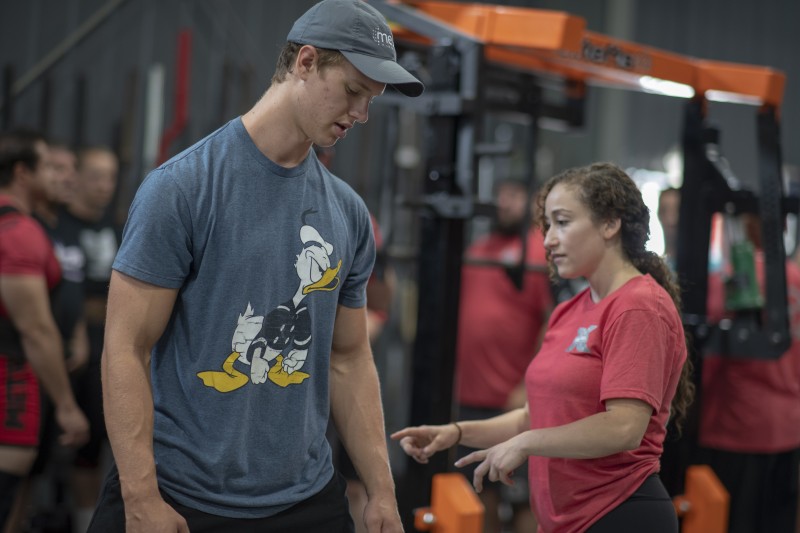
When we think about training to get bigger, faster, stronger, or whatever; we often put a ton of effort into worrying about how to program to maximize hypertrophy, what loads to use to get stronger, and how to optimize recovery. In my opinion, if you’re only worrying about those things, you’re missing the boat. All too often, I see people missing the importance of thinking about the muscle-brain connection when it comes to training. And that’s a bit of a shame because creating neural pathways that allow you to train and move correctly is a component of making gains.
Think about it. How many times have you warmed up to squat and got under the bar without even realizing your foot placement, bar placement, etc.? How often does that feel like autopilot? How many times have you done a terrible warm-up squat and promised yourself it would get better when you added weight but then it didn't? Or how many times have you grabbed a dumbbell off the rack and gripped it the same way without even thinking about it? I’m going to guess all the time. And it's not a bad thing; it's just a fact and a consequence of the neural pathways ingrained in your brain that have made these things second nature.
RECENT: The Science of Muscle Memory: Is it Real?
In the gym and in training, most people’s defaults are to go to whatever movement pathway has become their autopilot. I mean, heck, that's even true in life. People take the same routes to work, and they default to the same behaviors when stressed, etc. It's basically human nature to take a specific “normal” path and to divert from it only when necessary. So, for those of you who have become comfortable with some lousy gym habits that are holding you back, fear not, because I’m going to explain to you how new neural pathways are formed and what you can do to make some brain-specific training changes immediately (so long as you’re okay with dedicating time, effort, and consciousness to the task).
WTF are neural pathways, and how are they made?
I’ve been told it only takes 30 seconds of consciously thinking about something to build a new neural pathway, and that might be true. But it takes hours of repetition for it to become second nature.
The science community has done a lot of work in recent years showing that the brain can both make new neurons (neurogenesis) and new neural pathways (neuroplasticity)1-6. Neural pathways are just a series of neurons connected by single or bundled fibers that connect to send signals from one region of your brain to another or to the rest of your nervous system. Hence, these neural pathways allow your body to consciously and subconsciously carry out activities. Some of these programs are hardwired, like walking, and others are generated when you become exposed to new and different things.
To make a new neural pathway, you go through three stages: cognition, association, and autonomy. The cognitive stage is where you learn a new thing, like a new way to squat, by watching, doing, and thinking. It's the introductory phase to the new “motor pattern.” It's a hard phase because you need to figure out how to do the damn thing without reverting to old patterns. In the associative stage, you start doing the new thing more. This stage is where the newly learned motor pattern starts to become more natural. However, in this stage, the new skill/pattern/thing isn’t natural yet, making it somewhat frustrating. The final stage, the autonomous stage, is where you finally do the damn thing without consciously thinking about it. It’s the stage we all want to get to immediately but need to go through tons and tons of repetitions to get to.
How to train for new neural pathways
This weekend, at Learn to Train, we had many lifters come through our group, working on learning new neural patterns in an attempt to trade in suboptimal squat, bench, and deadlift patterns for some new, optimal ones. Building a new neural pathway, like they were trying to do, takes awhile. It is kind of like making a new path in the forest. You have to walk through it a zillion times before it goes from rough and awkward to worn down and natural. As such, the most important thing you can do when training a new neural pathway is to practice it over and over again. So, to train a new pathway, you have to drill the perfect execution of it over and over again. Do it with every warmup set, every working set, and every top set. And if you can, don’t take reps where you regress to a bad form.
It’s also really important to start slow. When you do a motor pattern fast or under a heavy load, this makes you susceptible to reverting to old neural pathways and complicates your neural learning abilities. However, if you slow movements down, and work on doing them right, it will be much easier to make them turn into second nature. Then, once it’s actually natural to you, work on speeding movements up or making them heavier. Additionally, either filming your lifting, getting a coach, or getting a training partner who can keep an eye on your technique is extremely helpful to do when you’re learning a new motor pattern.
So, at the end of the day, the next time you program, don’t just think about sets, reps, and exercises. Think about how you plan to execute those exercises as well as the cognitive steps you’re going to take to build neural pathways that help you to make training gains.
References
- Fuchs, E. & Flugge, G. Adult neuroplasticity: more than 40 years of research. Neural plasticity 2014, 541870 (2014).
- Gage, F.H. Structural plasticity of the adult brain. Dialogues in clinical neuroscience 6, 135-141 (2004).
- Leger, M. et al. Environmental Enrichment Duration Differentially Affects Behavior and Neuroplasticity in Adult Mice. Cerebral cortex 25, 4048-4061 (2015).
- McEwen, B.S. Structural plasticity of the adult brain: how animal models help us understand brain changes in depression and systemic disorders related to depression. Dialogues in clinical neuroscience 6, 119-133 (2004).
- So, J.H. et al. Intense Exercise Promotes Adult Hippocampal Neurogenesis But Not Spatial Discrimination. Frontiers in cellular neuroscience 11, 13 (2017).
- Zhao, C., Deng, W. & Gage, F.H. Mechanisms and functional implications of adult neurogenesis. Cell 132, 645-660 (2008).












Thank you so much for your time!